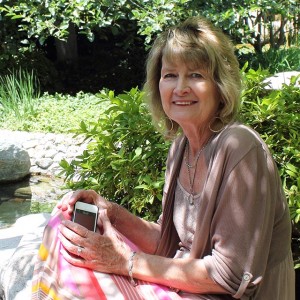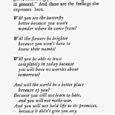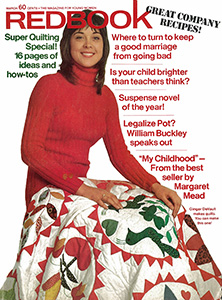
Karen Kenyon
Karen Kenyon had been writing stories and poems throughout her life, yet didn’t consider herself a writer until the birth of her second child. Johanna was a Down Syndrome baby. Then six months later, she died.
“I began to want to tell people about her and how she had changed our lives,” said Kenyon.
The resulting essay, “Johanna Was a Sun Shower,” was published in Redbook magazine in 1973. The essay is as beautiful as the meteorological phenomenon referenced in its title – rain falling while the sun is shining.
“This article changed my life and set me on the path to writing,” said Kenyon. “I started writing articles – on artists, and other interesting people. And I went back to college to finish my degree in writing.”
Years before her marriage and Johanna’s birth, Kenyon studied art at the University of New Mexico. By the time she returned to school, she and her family were living in San Diego, where she earned her master’s in English, with an emphasis in creative writing, from San Diego State University. Today, Kenyon is an award-winning poet, essayist and freelance writer who teaches her craft at the Osher Institute at SDSU (for students age 50 and better), as well as UCSD Extension and MiraCosta College – where she is an adjunct professor of creative writing.
The classes she has taught at the Osher Institute include “Writing Feature Articles,” “Writing Poetry,” and “Writing Haiku in the Japanese Friendship Garden at Balboa Park.”
Tell us more about how the publication of “Johanna Was a Sun Shower” set you on a writer’s path.
Until then, the only other thing I had written about Johanna was a poem when she was three months old. After she was born, I was going to a therapist and the therapist read it and said, ‘I want you to go home and send this out.’ I had a Ladies’ Home Journal and so I sent it there. Until then, I didn’t make the connection of how things got into magazines.
After Johanna died, I felt compelled to tell people about her. I wrote the essay and sent it to Redbook. Then I had an acquaintance tell me, ‘You shouldn’t have done that. According to the Writer’s Market, they don’t want unsolicited material.’ But the poem and the essay were published. I’m so glad I didn’t know what I was doing.
When Johanna died, her nursery became my writing room. There really was a complete connection there. I feel like people either are born a writer or something happens and you have to write about it, and that makes you a writer.
How did you get involved with the Osher Institute?
I had taught for SDSU Extension for many, many years — and then they weren’t offering the kind of writing classes I teach — so I was invited to teach for Osher. It’s just so pleasant. The students are exceptionally well-informed so it’s a pleasure to work with them. They bring a lot. They have a lot of knowledge which is so neat because then they share it. I was also really impressed with the other instructors at the orientation too. It’s so exciting … the art classes, science, philosophy, book clubs …
What makes Osher Institute classes unique?
Just the variety of people you meet. Some students are retired teachers and other professionals; some are still working. The first time I taught the Writing Feature Articles class, a young woman in her 30s came. She couldn’t find an article writing class so she came to Osher. (Editor’s note: the Osher Institute is designed for students age 50 and better, but adults of any age may participate.) In that same class, there was a man who writes for the Reader who wanted to explore other forms of journalism. You just never know who will show up.
In your Poetry class you teach specific forms that include the “found poem,” which I find delightful. Can you please explain what a found poem is, and some of the sources you’ve used?
It just means that you find a poem out there in the world somewhere, but it’s not designated as a poem. You do not change the words — you just rearrange them into poetic form (the line break). They are fun to do sometimes because you might feel peeved about some message that is absurd — and then realize it is so bad that it is good — and you can turn it into a found poem. I did that with a condo newsletter message once. Every word is taken verbatim:
ODE TO SPRING
CONDOMINIUM NEWSLETTER
JULY 2001
On recent inspection
we noted
new wind chimes
bird feeders
door wreaths —
Other decorations
have appeared outside
in celebration
of Spring.
While we appreciate
the sentiment
we must ask
that everyone
keep decorating
impulses
INSIDE.
Maintain
a uniform
exterior
appearance.
That is hilarious.
Yes, “found poetry” can sometimes be very healing! What really began my interest is a wonderful collection put together by Annie Dillard. It’s called Mornings Like This, and she created found poems from all kinds of unusual books — old medical books, old science books — and also Van Gogh’s letters to his brother, Theo. That one is called “I Am Trying to Get at Something Utterly Heartbroken.” It really touched me and I use it often in classes.
I’ve read that your father appreciated literature and quoted poems on long car drives. What were some of them?
They were the long epic poems that told tales like Robert W. Service poems (The Dangerous Dan McGrew) — and he loved Emerson. Also I recall something about Moll Flanders. I think when my dad was in school, students probably memorized poems, which we don’t do now unfortunately.
Who are your favorite poets?
I have many favorites — and this changes all the time too. I love Rumi, the 14th century mystical poet; also Mary Oliver; Jane Hirshfield; Robert Bly; Billy Collins; and Natasha Trethewey, our poet laureate.
Do you have a favorite haiku? Either your own or perhaps an unintentionally brilliant or funny one written by a student?
I have loved some of the haiku by my students, and in fact, at MiraCosta College, where each spring there is a haiku contest, a couple of my students do always win. One of my haikus is especially dear to my heart, probably because I wrote it in Paris — and for me it did kind of capture a brief time in a cafe, sitting in the rain, enclosed in those clear plastic shields they bring down to protect you from the rain.
Spring rain in Paris
Sidewalk streetcorner cafe
Dripping with chatter
Do most students share their work? Do non-sharers eventually get over their fear?
Writing and sharing are optional, but I find that generally all do want to write and share.
If you could go back in time and have tea with an author, who would it be?
It would be a Brontë, but can’t decide if it would be Charlotte or Emily. I would want to know what Emily did on those long walks on the moors. Her life is such a mystery — and she left hardly any personal writings. Wuthering Heights is so unusual. Where did this masterpiece come from? And with Charlotte I would just want to experience her powerful presence, and learn more about how she persevered. She was so tiny and evidently had these amazing eyes. I would like to see that.
You wrote a young-adult biography, The Brontë Family: Passionate Literary Geniuses (Lerner). How did your fascination with the Brontës begin?
I started going to England with my young son after my husband died and one of the things I loved was going to a writer’s house. So one year I thought it would be neat to go to the Brontë Parsonage. It’s in Yorkshire … you feel like you’re going back in time and you really feel the spirits of them. You get off the train and there are no signs that say ‘Brontë Parsonage.’ It’s just a little village with cobblestone streets. We had to ask people and they’d say ‘It’s just up the hill.’ It’s a house museum. We went back a second time too. I felt like they came home with me. And I just got emotionally attached and that’s what led to the book. I had already written two articles on them and it wasn’t enough for me. I loved working on the book. I spent six or seven years on it. If it had never been published, I would have done it anyway.
You also just published another biography, Charles Dickens/Compassion and Contradiction.
Yes, it was published as an ebook (Kindle) by a British digital publisher, Endeavor. It’s available on Amazon both here and in the U.K. (Editor’s note: It’s also a finalist for a San Diego Book Award in the biography category. The awards ceremony is June 21, 2014.) …. The book of Dickens that always affected me was a Tale of Two Cities. It had been significant because I come from Oklahoma and when my parents divorced, we moved to Sacramento. Back in those days it was like moving to another country. It was like my Tale of Two Cities. We read it out loud in class and the teacher picked who would be each character and she picked me to be Lucie Manette. I identified with her. Lucie pined for her father and I pined for my father who was back in Oklahoma. Then we moved to the other side of town and again the teacher picked me to read that part.
Any other books in the works?
My book of poetry is underway and slated for publication, but I still have a lot of work to do on it. I’ve also written five or six chapters of a historical novel on Charlotte Brontë – she’s the one who wrote so many letters and journal entries. She lived to be 38. Charlotte put all her feelings and emotions into her journals so you can really understand her and the way she thinks. She always wanted love more than anything. Four different men asked her to marry them and she ended up falling in love with her father’s assistant minister. He won her over because he loved her so much. She married him, and then she died while pregnant. For years they thought she had TB but later, because of different documents and her writings, it turns out she had severe morning sickness, like Kate Middleton had. There was no treatment for it at the time and she just wasted away. They’d only been married nine months. Charlotte had told a friend, ‘I’ve never been so happy.’ I feel it should be an opera. It’s such a powerful story.
Have any of your Osher Institute students gone on to be published poets or freelance writers?
I don’t usually have an ongoing relationship or contact with my students from Osher, so I can’t say. Though it’s possible. One student, Diane Altona, has been in a couple of my Poetry classes — and she is an excellent poet, and could be published, I’m sure, if she wanted to be.
Are many of your students retired from a left-brain careers and now finally addressing suppressed right-brain interests?
Some are retired from the left-brain careers — but some have always liked to write and they want to continue and have new inspiration and feedback.
Has teaching Osher Institute students inspired you?
Yes, definitely. I love meeting people from all kinds of backgrounds and ways of life — and this uniqueness does come out in students’ writings.
The best writing tip I ever heard was “write like you talk.” (Does not apply to poetry, of course.) Would you agree?
I do think we should all be more in tune with our own “voice.” So I guess that does include how we talk. But also I think we all have a personal writing voice that may be different from our speaking voice, and yet is uniquely our own. I think it takes trusting yourself, and not worrying about who will be reading your work, to coax it out.
Based on your career trajectory, you seem unafraid to pursue any creative interest. Is there one you haven’t yet tackled?
I don’t have any musical talent. I love it so much though, and my mother was a pianist, so I grew up in a house filled with music. As far as writing goes I have never written a play — though I did write a piece for a Readers’ Theatre performance.
What words of encouragement would you give to those who have yet to pursue their creative dreams or even just take a class at the Osher Institute?
Well, it’s a cliché — but it truly is never too late. I’m working with a retired lawyer in another class of mine — and he said he just woke up from a nap and wondered what it would be like to be a poet! And he is writing some amazing poems — even though until now he had never written that sort of thing, and certainly didn’t have feedback. The great thing about the creative arts is that a person can be involved all during life, and just go deeper and deeper. You don’t retire from being a poet, artist, or musician!
Kenyon is also the author of Sunshower (New York: Putnam & Sons), a memoir on her family’s gradual recovery from her husband’s suicide. Published in 1981 and reprinted in 2000, the book is a highly regarded addition to the literature on suicide.






